Mahana
Federal Democratic Republic of Mahana संघीय लोकतान्त्रिक गणतन्त्र महान Saṅghīya lōkatāntrika gaṇatantra Mahāna (Mahanan) | |
|---|---|
Coat of arms
| |
| Motto: "Adbhuta pahāḍī rājya" "Bound by Democracy" | |
| Anthem: Rastiyah Ghaan | |
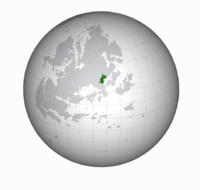 Location of Mahana on Eurth | |
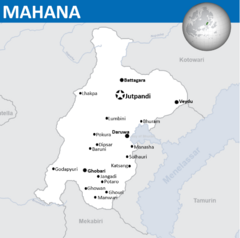 Map of Mahana | |
| Capital and city | Jutpandi |
| Official languages | Mahanan |
| Recognised regional languages | |
| Ethnic groups (2012)National Census | [1] |
| Religion | |
| Demonym(s) | Mahanan/Mahani |
| Government | Federal parliamentary republic |
• Prime-Minister | Ranju Bastola |
• President | Bina Sharma |
| Legislature | Federal Parliament |
| National Assembly | |
| House of Representatives | |
| Area | |
• | 241,600 km2 (93,300 sq mi) |
| Population | |
• 2021 estimate | 29,800,00 |
• 2012 census | 29,686,017 |
| GDP (PPP) | 2021 estimate |
• Total | $127.22 billion |
• Per capita | $1,867 |
| GDP (nominal) | 2021 estimate |
• Total | $36.084 billion |
| Gini | 32.6 medium |
| HDI | medium |
| Currency | Mahanan Paisi (PAI) |
| Time zone | UTC+8 |
| Driving side | left |
| Calling code | +989 |
| Internet TLD | .mh |
Mahana (Mahanan: महान or Mahāna|IPA: mæhˈɑːnə listen)[4], officially the Federal Democratic Republic of Mahana is a country in Europa, more specifically the sub-continent of Orient, which consists of 29 million people. Mahana is bordered by Kotowari to the north, Namdatka to the west and Mekabiri to the south. The capital city is Jutpandi but other large cities include Ghobari, Daruwa and Veydu. The most notable feature of Mahana is the Samripe Mountain Range, one of the largest on Eurth, and specifically Mount Monjara, standing at 7,963m tall. The most followed religion in Gaism, a religion centred around the worship of the bovine God of Kuladara. Mahana is made up of a huge amount of differing ethnic peoples, including the Sheshtri, Gaimreti and the Mais. The name 'Mahana' literally translates to 'Great' in the native language.
Modern humans arrived in Mahana no later than 70,000 years ago[5], following their migration from Azania. Their long occupation, initially in varying forms of isolation as hunter-gatherers, has made the region highly diverse with many differing ethnic groups existing into the modern day in Mahana and neighbouring countries. Settled life began with the Ghobari Valley Civilisation, with earliest evidence suggesting that it dates back 7,000 years. At around 4000 BCE, Gaism was founded in the northern Ghobari Valley. By 3000 BCE the Jhuapi Punha Dynasty had risen and brought with it an ancient form of the Mahanan language, Kulura. At the end of the Vedyuan Period (1300BCE) Mahana had began to be mentioned in Gai texts and by 600 BCE the Shakyans had arrived in the Mahanan Lowlands. Another major event of this period was the birth of Vuatama Buddha in Lumbini who would go on to found Buddhism. The Aayan Empire got control of the Patuan region as well as the areas surrounding the ancient city of Vaddkewatta, creating the largest empire in Orient for a small amount of time. One of the leaders of the empire, Emperor Ujesh, established the beginning of recorded history in Mahana. The Aayan Empire[6]. collapsed by 50 BCE, leaving Mahana to be split into three kingdoms. Following a war between the empires, which ended in victory for Raj I's Nadali Empire, Mahana united under one banner for the first time in 1100 AD.
The city of Jutpandi was established in the year 1183, acting as a centrepiece for the newly united Mahana. The first real threat to Mahana was the Khaddic Empire from central Europa who felt that the areas of the plateau occupied by Mahanan forces belonged to them, due to the historic presence of the Patuan peoples in the region. The war between them ended in a majority Mahanan victory, as well as the establishment of the esteemed Durkha for the first time. In 1222 the rich language and cultures of the Patuan people began mixing with the ancient languages of the ethnic Mardri peoples of Mahana, forming the medieval version of the Mahanan language. The Caste System[7] was introduced by 1287, leading to a socio-economic reform. By the late 14th century, it is thought that Mahana was a strong regional power. However, in the 15th century Mahana began to lose land in the west due to lack of resources. This caused a temporary division of Mahana with the Kingdom of Ripali occupying the eastern portion of Mahana for the majority of the 15th century. These people had access to better fertile farmland and material and their existence harmed the power of Mahana. However, Mahana managed to recapture the lands during a flood season in 1466. Small conflict took place between Mahana and Namdatka as Queen Sabitri II lead land reforms into the Careleon Plateau. In the late 18th century, Mahana began to have religious struggles with the Hindu population believing they were being mistreated by the government, seeing a mass migration of Mahanas Hindu population to the Hindu Kingdom of Kotowari. Although, changes were made due to the protesting of activist and politician Saroja Suwal. In 1799, Mahana had a one year long war with Mekabiri following the Bureman Incident which lead to a Mahanan loss as well as a loss of land to Mekabiri. In 1833, the Delamarian port and trading post in Daruwa launched an invasion into the city, taking it under control of Delamarian Daruwa and the ruling Delamarian Oriental Company. Although, after work from Lalit Gaudel, Mahana declared war on Delamarian Daruwa to kick them out of their lands and regain the city taken for them. In the 20th century, the people became upset with the absolute ruling of Mahana's monarchy, which lead to widespread protest and the eventual Mahanan Civil War of 1992. The Civil War ended in Republican victory and the death of Raju II and Raju III as well as other members of the royal family in the massacre at the royal palace. Since then, Mahana has been a parliamentary republic, lead by the majority Mahanan Congress.
Mahana, despite historically being isolationist, currently have positive relations with a majority of Eurths countries, being a member of many international organisations such as Oriental Association for Regional Cooperation (OARC), the Entente of Oriental States (As an observer[8]) and the Assembled Nations. The nation has been a democracy since the Mahanan Civil War of the early 1990s, which overthrew the Monarchy in Mahana. The current Prime-Minister is Ranju Bastola and President is Bina Sharma.
Etymology
"Mahana" (Mahāna, महान, mæhˈɑːnə) comes from "Da Majānara Bhūmi" which means "The land of the Majans". The Majans were a group that, before migrating into central Europa, inhabited the western portion of Mahana around the outer Careleon Plateau region. A collectivised horseback riding tribe, the people moved on to modern day Chyrcassia leaving the name with the land.
The origin of the name "Majan" is unkown, with the first appearance in a historians account of early Mahana from around 400 years after the departure of the group.
The first known reference to a land named "Mahana" was much later in history, in early Gai texts from toward the end of the Veyduan Period (1300 BCE), where the holy land was referred to as "Mahanaii" (महानाई). Overtime this developed into the modern name, with the first appearance of the modern spelling (महान) was in the unification texts, during the reign of King Raj I:
"आज स्थापना दिवस हो महानन साम्राज्यको, एक झण्डाको रूपमा एकजुट. शताब्दीयौंको युद्ध पछि हामी अन्ततः गाई र बुद्ध प्रभुहरूको अधीनमा एक भएका छौं"
"Today is the founding day of the Mahanan Empire, united as one flag. After centuries of war, we are finally united under the lords of Gai and Buddha".
The name wasn't used locally until much later in history, however, as many used local autnomous region names when describing their place of origin.
History
Ancient Mahana
Prehistory
The first evidence of human presence in Mahana can be dated to around 70,000 years ago from Azania where they evolved. The earliest modern humans likely began to appear closer to 55,000 years ago. The oldest archaelogical evidence of human settlement in Mahana dates to even later, around 40,000 years ago.
After 7,000 BCE evidence of early animal domestication, storage of agricultural surplus as well as permanent construction was found. Over time these developed into the early Ghobari Valley Civilisation, evidence for this can be found in the Mugarati and Plunbit sites in the south of Mahana. Mesolithic and even palaeolithic evidence has also been found in the Bhetwal Province. It is believed, because of this, that Mahana and areas surrounding was one of the first areas settled by humans in Orient. By around 4,000 BC the earliest Patuan peoples arrived to the Careleon Plateau, which was not yet a desert-plateau at the time. The origins of these people is unknown, however by most it is believed they must have originated from central Europa, as well as evidence of this in DNA. It was also around 4,000 BC when the first mentions of very early Gaism appeared in the Ghobari Valley.
Around the year 3,200 BC it is believed that the early Mardri peoples developed from the Ghobari Valley Civilisation and spread into the Patu and Ripal regions, establishing early city civilisations. This is known due to the fact it was recognised by early Gai scripts. The separation of the peoples in Mahana lead to huge ethnic diversity, with languages used between the regions being completely separate. The eldest established dynasty in Mahana is believed to be the Jhuapi Punha Dynasty, which was established very close to the modern capital of Jutpandi. It was also with this dynasty that the language of Kulura was established, which is believed to be the earliest ancestor language to modern Mahanan.
The Carelitan language also began developing in the Careleon Plateau, evidence suggests, around the year 2,900BC. Mahana also received small populations from the early Shakyan civilisation to the north around a similar time. Towards the end of the Veyduan Period (1,300BCE) Mahana had been mentioned on multiple occasions throughout Gai texts as well as multiple Hindu texts. The Topal Gura Dynasty began being mentioned in texts, being the second dynasty named in religious texts. The Topal Dynasty founded the ancient city of Nupakara, modern-day Ghobari. Evidence suggests there was large scale infighting between the Topal Gura Dynasty and the Jhuapi Punha Dynasty in western Mahana.
Trade between dynasties and kingdoms within Mahana began to boom around 900BC with all kinds of agriculture and valuable items being passed between the kingdoms and dynasties. Around 600BC, further small kingdoms appear in the eastern regions and around the Mahanan Lowlands. Most of these would be cleared off in 500BC as the Shakyans arrive and occupy a majority of the lowland region. The Shakyans managed to push back the Topal dynasty and occupy a majority of modern western and southern Mahana. From the Shakyan Dynasty arose a local prince named Vuatama Buddha who would become a founder of the Buddhism religion in Mahana.
Mahana became a land of religious importance and spirituality being the home of the Gaism religion for all of the world as well as one of the world centres for Buddhism. The first leader of Gaism, known as the Gai, settled in the ancient city of Vaddkewatta, now known as Jutpandi, in 433BCE. Mahana became rich from the ancient pilgrimages where the pilgrims were encouraged to give money to the Gai.
By 230BCE, Mahana became integrated with the Pearl Road network as part of the Shakyan Principalities in the east. This opened Mahana to resources and goods that they never had access to before such as silk, glass, luxuries, gold and even timber. In return Mahana exported through the network pearls from the Bay of Bhuram as well as raw materials from the Samripes.
By around 110BC, the western regions of Mahana around the Careleon Plateau and the ancient city of Vaddkewatta came under the control of the Aayan Empire. The third emperor of the empire, Emperor Ujesh, took a spiritual pilgrimage to the Buddhist site Lumbini. When there, he erected a pillar with inscriptions which would mark the beginning of recorded history in Mahana. On the same pilgrimage he would also visit Vaddkewatta to get the blessing of ruling from Gai Palash II.
Following the blessing from the Gai, Emperor Ujesh lead the people of Aaya to war with Shakya in order to recapture the Mahanan lands that they felt belonged to them, according to the 'Nabendu's inscriptions'. After a successful invasion of Shakya, they managed to push the Shakyans out of Mahana in 8BC, giving the Aayan Empire almost all the land within the modern Mahanan borders.
The Aayan Empire collapsed in 50CE following loss of territories due to weak sucession of emperors. Following the collapse, the Nadal Empire arose as the most prominent power in Mahana alongside the Ekaviri Empire. Alongside these two empires existed many small kingdoms and communities which would often be overthrown by the two major powers.
Interaction between the kingdoms was minimal going into 200CE, with trade made minimal by the kings and emperors. Despite this, neither side wanted war as not to risk losing great resources or men.
It is believed that, for the first time, in 703 the Nadal Empire laid claim to the Samripe Mountain Range, with the blessing from Gai Tej III giving them an excuse to take the unclaimed lands. Before this, it is believed the mountain range's only inhabitants were small groups of ethnics and tiny kingdom states. In the Ghobari Valley the Nadal Empire had been pushed north by the Kurula Dynasty from Mekabiri c. 849. This lead to a third major player in Mahana at the time. The Kurula Dynasty were lead by members of the Nupashi Family, who were heavily Buddhist and saw the sacred birthplace of Vuatama Buddha as rightful territory of the Kurula Dynasty.
The Kurula Dynasty easily managed to push the Nadal Empire north, due to how decentralised and unorganised the empire was. This caused the collapse of the Nadal Empire, leaving the Kurula Dynasty by far the largest and richest entity existing in Mahana. Complete Mahanan unification became an idea in c.1,023. The idea came around as Gai Tej V claimed all the holy lands of Gaism should be united under a single banner. This caused the beginning of the Kurulan Crusades led by King Raj I which ended in the collapse of the Ekaviri Empire as Veydu fell. This marked the beginning of the medieval era in Mahana, as Mahana became a united sovereign entity for the first time, under King Raj I.
Medieval Mahana
Early Independence
By 1100, Mahana had begun to stabilise as a sovereign entity with a strong monarchy being established, with many reformers amongst the first monarchs. They worked to centralise the government, establishing the city of Jutpandi as the capital in previous Vaddkewatta.
The first threat to power in a unified Mahana was the Khaddic Empire from central Europa and the Careleon Plateau who felt that the areas of the plateau occupied by Mahanan forces belonged to them, due to the historic presence of the Patuan peoples in the region. A notable event of that came from the Khaddic Empire was the foundation of the earliest Durkha mercenaries and religious war monks. The Khaddic Empire would send a long list of demands to the Mahanan government every year, and after twelve years of appeasement, Mahana could no longer afford to pay the appeasement prices. This lead to a declaration of war from the Khaddic Empire, starting the War of Santuṣṭi (beginning 1123). The territorial peak of the Khaddic Empire included a majority of western Mahana, including a huge victory in Jutpandi. However, following defeat at the end of the war the Khaddic Empire split up into loosely associated kingdoms which would eventually be reabsorbed into Mahana, as well as surrounding nations.
In 1207, Mahana annexed several more Patuan kingdoms, expanding further west than the present day borders. As well as this, the people began developing further toward the Samripes. The rich language and cultures of the Patuan people began mixing with the ancient languages of the ethnic Mardri peoples of Mahana, forming the medieval version of the Mahanan language.
Caste Era
By 1287, King Rabi I ($born-$died) had introduced the caste system to Mahana, a socio-economic reform which divided the indigenous Mardri peoples and the Buddhist population into castes modelled after the four Varna system of Hinduism. The king provided an influential model for the Sanskritisation and Hinduisation of the indigenous non-Hindu tribal populations in all principalities throughout Mahana.
By the late 14th century, it is said by Seylosian historian Kirkpatrick (1823-1890) that Mahana had become a large regional power, capitalising on the Orinese colonial period that had weakened fellow regional powers, including Mekabiri. Despite this, Mahana was affected on a minor scale by the colonial period, as it was hit with small scale coastal raids in the Bay of Bhuram. Apart from one sacking of Jutpandi by Patuan revolutionists in 1492, Mahana remained relatively isolated and untouched from outside powers.
During the 15th century, Mahana began to lose land and weaken as a regional power due to its notable lack of resources in the west. This caused a temporary division of Mahana with the Kingdom of Ripali occupying the eastern portion of Mahana for the majority of the 15th century. These people had access to better fertile farmland and material and their existence harmed the power of Mahana in the west as it took a large amount of resources from them, and trading it back to the government for large prices. However, the Kingdom of Ripali was located entirely in the lowland Mahanan Lowlands region, which during certain months had heavy flooding. One such year, 1466, Mahana invaded the Kingdom of Ripali during a three-month flooding period, bringing it back under Mahanan rule.
Expansion and Reforms
In the mid-to-late 16th century, a Mahanan Queen named Sabitri II ($born-$died) began reforms which involved the expansion and reclamation of land that was owned under the Aayan Empire, seeing it as Mahana's divine right to own the land in accordance to the Gai. The Queen's soldiers began marching west to reclaim the Careleon Plateau regions previously under control by the Aayans, only stopping just before the modern border, evidence suggests. The soldiers deployed brutal techniques in subduing the Patuan populations, pushing back the recently independent Namdatka. The Queen's men used skill on horseback in order to effectively and quickly dispatch of any who resisted their claim of rule.
Throughout the 17th and early 18th century, Mahana worked on stabilising relations with Namdatka and worked to hold off foreign kingdoms. However, it was also within these years that they opened formal relations with their neighbours, breaking their isolationist stereotype. They opened formal relations with Kotowari in 1644, Namdatka in 1671 and Mekabiri in 1700. Apart from the small naval invasions from the Orinese in the 1350s, Mahana remained fairly untouched by foreign powers going into the 18th century.
The rising tensions in neighbouring occupied Mekabiri saw a large influx of Mekabirian refugees and immigrants entering Mahana, who would stay until the tensions surrounding Mekabiri's independence ended in 1822. These Mekabirians would soon integrate with the Mahanan people and by the 18th century there was a large amount of mixed ethnicity Mahanan-Mekabirians.
Consolidation and Stabilisation (1768-1899)
Religious Struggles
Religion in Mahana began to become a topic of controversy, with major Buddhist, Gai and Hindu populations. The religious tensions began as the largest Hindu Mandir in Battagara was bombed by Gai extremists. Small scale attacks on individuals and similar places of worship, however, were carried out by both groups. The Hindu population of Mahana at the time was much higher than in present day, making up roughly 32% of the population, compared to the current estimate of 4.4%. The reason for this was, in 1779, a religious leader known Prajesh N. encouraged the Hindu populations to move back to Kotowari, a land much less oppressive towards the Hindu population than the Gaism-centric Mahana.
In 1798, with huge rising tensions between the religious groups rose, with hatred and conflict common between the groups, a political figurehead named Saroja Suwal began starving herself until the government agreed to help put a stop to the segregation and conflict between the religious groups and minorities in Mahana. Suwal was wildly successful, with people rallying behind the public figure in support of the desegregation and fair treatment of the religious groups. The movement for the equal rights of religious groups became huge, with some of the nation's largest political figures joining in on rallies and marches, such as the Jutpandi March and the Butwal Rally. These events ended in a law of desegregation being passed, however some damage was done and Hindu and Buddhist populations began a gradual decrease which would continue until the 1980s.
1799 Mekabirian War
Tensions began between Mekabiri and Mahana in 1799, with the Mahanan region of Bidakiye (present day Mekabiri) which the Mekabirians saw as rightful territory. The region had a large majority of ethnic Mekabirians. Problems arose as the minority of Mahanans in the region felt strongly about the region's continuation as a part of Mahana, and as support for incorporation into Mekabiri arose, the Mahanans in the area began to cause problems with the majority Mekabirian population. Violent fights between civilians became a commonality, often having to be resolved by military force. One such occurrence was the November 1798 Bureman Incident, which sparked the government of Mekabiri to threaten war over the region due to the poor handling and slaughter of Mekabirian citizens. Mekabiri believed that the Mekabirians affected were targetted over the Mahanan citizens of Bureman.
Following these events, Mekabiri used this as their reason to occupy the region that they saw belonging to themselves, marching their men into the region on the 6th February 1799. This was met with great resistance from the Mahanan troops, who tried pushing into the city, causing a great loss of life during the Battle of Six Waters, which ended in a majority Mahanan victory thanks to the elite fighting style of the Durkha. This ended up being the first of many battles along the border, including the Battle of Bidakiye (Mahanan Victory), Battle of Guraon (Major Mekabirian Victory). The war became a stalemate in 1801, with previous years being Mahanan dominance due to the Durkha.
Due to a huge economic loss, Queen Dipshika I signed a treaty with Mekabiri, ending the war and giving them the Bidakiye region that they started the war over. The reason for this was that, with tensions rising with the Namdatkans in the west, they couldn't handle two conflicts at once. As well as this, they needed to save just in case war with the Namdatkans came.
Conflict of Vivāda (1812-1813)
Mahana, after recently losing land in the south to Mekabiri, were trying to avoid a war with Namdatka over the outer Careleon Plateau, a desolate region which was not of much use to the Mahanan people. However, to avoid complete embarrassment, when the Namdatkan soldiers invaded the region, the Mahanan Army responded with almost 3,000 men. Despite taking victories in many battles, they withdrew from the outer regions, as not to lose too many resources or men to a conflict not worth fighting. In total, it is estimated they lost 540 soldiers during the conflict, with the Namdatkans losing many more.
Despite this, they established a line of defences along the Majuri River, known as the Majuri Defence Line, in order to keep a hold of the more fertile inner Patuan region. This was successful, managing to hold off any further Namdatkan invasion from the west.
Delamarian Daruwa
In 1833, the Delamarian port and trading post in Daruwa launched an invasion into the city, taking it under control of Delamarian Daruwa and the ruling Delamarian Oriental Company. They held the city for over thirty years due to the defences they built, the supplies they received through the Bay of Bhuram. As well as this, Mahana had no reason to recapture the city, as it would be risking a war with the powerful colonial empire which was Delamaria. Furthermore, they did not have much use of the port city, due to the city being used as the headquarters for the Delamarian Oriental Company for decades before the colonisation.
Tensions rose as those running the colony began enslaving the people of the city, using them for forced labour. They treated the people of the city harshly, and the Mahanan government refused to acknowledge these happenings, causing widespread outrage for Mahana to get involved and recapture the city. In 1861, a Durkha named Lalit Gaudel became the leader of the movement when he became one of the first Durkha to publicly abandon their duties as a Durkha in order to send a message to the government that change had to be made. Many Durkha followed his footsteps, with his inspirational speeches and stances becoming legend within Mahana. It is believed he, almost single-handedly, lead to Mahana's promise to get involved with the city.
The King telegrammed the leader of the Delamarian Oriental Company, with a list of demands which involved the abolishment of slavery in the colony. These were declined by the leader, and a declaration of war was made, beginning the Delamari-Mahanan War. To begin, the Mahanan troops found it difficult to even get into the city, with trench and widespread warfare taking place in the country outside the city, with small advances being made due to the technological advantage that the Delamarians had over the city. Mahana began to get an upper-hand as Mekabiri offered their soldiers, roughly 5,000, in aid of Mahana. This was due to their shared anti-colonial views following the Orinese colonial period. The further turning point was the involvement of the Durkha, who had previously lost many of their numbers due to Lalit Gaudel's movement, however had begun regaining their previous members due to Mahana's involvement.
The Mahanan forces breached the walled, defended city in days. Over the course of the first few months, Mahanan ground troops were sent in, with the nation's navy lacklustre in comparison to the Delamarian navy. The troops struggled against the heavily trained and skilled Delamarian soldiers within the walled city. Some of what happened following is assumed to be myth, however it is known that the Durkha were sent to recapture the city after three months. It is said that 400 Durkha soldiers entered the city, against the almost 3,000 Delamarian soldiers, and won. The famous story of Durkha Bajra Singh came from the battle. Legend states the Bajra Singh single-handedly held off almost 50 Delamarian soldiers in an alley within the city, however the reality of the story has been questioned since.
With Mahana almost in victory, they blocked the entrance to the Bay of Bhuram with their only navy fleet, sinking multiple trader ships, finding onboard weaponry which was seized for the Mahanan military. This, as well as a successful ground invasion, lead to the capitulation of the Delamarian Daruwa Colony. The treaty that officially ended the Delamari-Mahanan War included a written request from the king, stating: 'In exchange for your abstinence in our lands, we will send with you a dozen of our own, our Durkha', which led to the end of Delamaria's presence in the Orient.
Contemporary Mahana
In 1902, the Misran Dynasty was founded by newly coronated Prajeeta II and her husband.
In the early 20th century Mahana became one of the earliest countries to be affected by the Byzantine flu as it was transported to the country through the trade route with Miiros through the Byzantine Sea and into the Bay of Bhuram. It spread quickly in the eastern regions of the country into major cities such as Veydu and Daruwa, where by late 1915 it had infected an estimated 100,000 people. The flu spread fast and was incredibly deadly as the region was fairly poor under the reign of Prajeeta II and Rajya III, with people living in close slums and allowing for the pandemic to spread quickly. As well as this Mahana had never faced a major pandemic in it's history, and was not equipped to handle the spread of the infection as they were behind much of the wurld when it came to advancements in medicine. By 1917 it had spread to the western regions as well as the capital of Jutpandi. It became such a problem as even Rajya III's son and heir to the throne Nuri got the flu and passed away in November 1917.
A turnaround was made in 1918 as other nations around the wurld became aware of the ways to combat the flu, and word spread to the governing bodies of Mahana who implemented some of the methods to doing so such as quarenteening and social distancing but also closing down many public areas. They spread the word in national newspaper and by 1920 the last ever case was reported in Veydu, before fading out as it did in the rest of the wurld however it wasn't without the loss of an estimated 250,000 Mahanans[10]
Monarcho-Issues and Civil War
In the late 1940s, pro-democratic movements and political parties began to become critical of the monarchism of Mahana, with the Misra Dynasty being in absolute power for almost 110 years as of the 1940s. Similar movements in neighbouring countries, which Mahanans participated in successfully, helped with the support with the movements. King Raju II (1927-1992), who was made king aged only 5 which gave him the nickname 'Boy King', was strongly opposed to the movement, declaring any support of the pro-democratic movement to be illegal. Raju II was a specifically harsh leader, hoping to keep his family's legacy alive, even with an unstable population. The censorship of media came into place in 1971, and it was one of the final turning points.
The Mahanan Socio-Party was formed first in 1973 as a movement for pro-democracy and anti-monarchism, gaining support over the coming years due to their marketing campaigns and small-scale attacks onto pro-monarchy supporters and oligarchs. Riots began in cities, with many being silenced by police and even the military. The nation's Durkha left to serve foreign countries, seeing it as not following their code. King Raju II stepped down in 1988, sensing a conflict to come and not wanting to risk his legacy as king. Replacing the king was his younger brother, King Raju III (1930-1992).
In 1991, the Monarchs threatened to completely reject the idea of a democratic society. This led to the beginning of the Mahanan Civil War in January 1992, with over 16,000 deaths in total and ending in a republican victory following the massacre in the royal palace. Raju II and King Raju III were both killed in the massacre. The Mahanan Congress was placed into power until Mahana stabilised to form an election, which, upon the signing of the updated constitution, takes place every 6 years.
Post-Civil War to Modern Day
The first official democratic election was held in 1993, a year after. The Mahanan Congress won anyway, with the first President, Saurabh Baidhya, taking office. They joined mainstream politics following the peaceful democratic revolution of 1995. Mahana became a secular state, and on 28 May 1996, it was declared a federal republic, ending its time-honoured status as the world's only Gai kingdom.
For the final time, in 2003, Mahana created a new constitution, making Mahana a federal democratic republic divided into seven provinces. As well as this, it gave Mahana a seperate Head of State and Head of Government, a President and Prime-Minister respectively. This became controversial as they are from the same party.
Mahana began to rebuild their economy in 2006, investing massively into tourism and agricultural sectors. Tourism, in the present day, takes up 9.7% of Mahana's GDP. The only event to have effected Mahana since the Civil War of the 1990s was the April 2010 eurthquake which severly damaged infrastructure in the areas surrounding Ghobari, causing landslides from the Samripes which caused 13 deaths.
Geography
Mahana is an oddly shaped country, with a fairly square shape but with two similar looking panhandles in the north and south. Mahana's key geographic features originate from the Europan Plates 79 million years ago, the Samripe Mountain Range. The rising of these plates also blocked the paths of rivers creating large lakes, which only broke through as late as 100,000 years ago, creating fertile valleys in the middle hills like the Ghobari Valley. In the south-eastern area, known as the lowlands, consists of fields perfect for rice harvesting as well as land for agriculture. On the west side of the Samripes is the Careleon Plateau, an area of relatively low relief and uninhabitable lands. Despite this many ethnic groups call the plateau home.
Mahana is seperated into three physiographic belts, known as Ripal-Juhada-Patu. Ripal is the name for the lowlands region which is home to the majority of Mahana's agriculture, which also borders the Bay of Bhuram. This area contains the lowest areas in all of Mahana and is part of the larger Koto-Mekibiri Plain. Juhada is the region that houses the Samripe Mountain Range, as well as Mount Monjara (7,963m). This area is incredibly mountainous, with heights just shy of 8,000m far from uncommon. The Patu region is a large plateau, home to hunter-gatherers and native groups. The region can be harsh and production of goods is hard in areas, however in the eastern-most regions of Patu is the cities of Jutpandi and Battagara. In the northern points of Patu is another much smaller mountain range, the Shrikrishna Mountains, which has moutains ranging from 2,500 to 400m in height with arid river valleys flowing from as far north as Zekistan. Mahana has one of the largest river systems in the Orient, with rivers such as the Nupasha River, Kapali and the relgiously important Chaudhuri as well as many smaller rivers rising below the permanent snowline.
Due to it's position on a fault in the Europan Plate, Mahana is at high risk of earthquakes and in the past periodic earthquakes have taken great effect on the nation's economy and been a hurdle in development. Erosion of the Samripe mountains is a very important source of sediment to Mahana, which flows into the Bay of Bhuram.
Mahana experiences five seasons, similarly to other Central Oriental nations, summer, narope, autumn, winter and spring. Winters are warmer in Mahana than elsewhere as some of the cold air from central Europa is deflected by the mountains.
The Samripe Mountain Range from the east camp of the peak X92.
A river valley in the Sheshtri National Park.
A temple in the side of a mountain, Nuragara Province
Biodiversity
Mahana contains a disproportionally large diversity in climates, plants and animals in relativity to it's size. Mahana has notable biocultural diversity due to it's varied environments. The huge, dramatic differences in elevation from the Inner Careleon Plateau as low as 64 metres above sea level to the peak of Mount Monjara at 7,963 metres above sea level. The Ripal Region (east) is home to the richest biodiversity due to the conditions, with the majority of the Patu and Juhada regions being too harsh to support large amounts of biodiversity. Mahana is home to 7.3% of all mammals, 15.4% of all birds, 2.0% of reptiles, 5.3% of all amphibians, 2.2% of fish species, 6.7% of all butterfly species, 0.5% of all moth species and 1.2 of all spider species. It is also home to 111 IUCN-designated threatened species, with 86 of them being animals and the other 25 being plants. These include the Koto tiger, the Red panda and the Samripen musk deer.
The nation also has a good animal conservation program, with species such as the Nupasha river dolphin, Red panda and the Aziatic elephant being under strict protection by law. Mahana is also home to four national parks, with one of them being an international site of interest, the Samripe Mountain Redwoods Park.
Mahana's forest coverage is 64.3% of the nation's total land area. In the Ripal region you can find tropical evergreen forests, subtropical forests as well as temperate broadleaf and mixed forests. In the Juhada region there is widespread pine forests and subtropical pine forests.
Politics and Government
Mahana is a parliamentary republic with a multi-party system. The three parties that are recognised by the federal parliament; the Mahanan Congress (MC), Mahanan Red Workers Party (MRWP) and the Simatra Jima Party (SJP). The MRWP is considered leftist, the Mahanan Congress is considered centrist and the SJP considered right leaning. Since the establishment of the parliamentary system the Mahanan Congress has been the most sucessfull, holding the majority of seats during each election so far, only being rivalled by the MRWP in the early 2000s and mid 2010s. Previous to the establishment of Mahana's parliamentary system, they had a 'Parliamentary Monarchy', however most historians would consider it to have been an absolute monarchy due to the fact each of the parties were owned by the monarch, prior to the early 1990s. Some examples of parties from this time period include the Crown Juti Party and the Democratic People's Party.
Government
Mahana is governed in accordance to the Mahanan Constitution, written in 1993. The constitution outlines the nation as having multi-ethnic, lingual, religious and cultural characteristics that unite for a common aspiration for people living in a geographically diverse land and being dedicated to preserving the national independence and territorial integrity of the land.
Administrative Divisions
| Province | Capital | Governor | Chief Minister | Districts | Area (km2) |
Population (2011) |
Density (people/km2) |
Human Development Index | Map |
|---|---|---|---|---|---|---|---|---|---|
| Nuragara Province | Jutpandi | Palash Piya | Rajendra Ra | 18 | X | 8,334,230 | X | 0.578 | 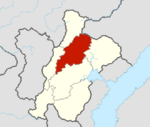
|
| Sadheshi Province | Veydu | Hari Hankar | Lalbabu Raut | 8 | X | 5,132,494 | X | 0.472 | 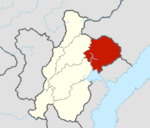
|
| Banurati Province | Daruwa | Chandra Shoama | Prasad Pandey | 10 | X | 6,493,329 | X | 0.488 | 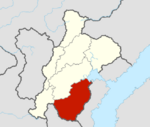
|
| Thubten Province | Sherabi | Tempa Pakshi | Paldon Sambhota | 6 | X | 2,403,757 | X | 0.428 | 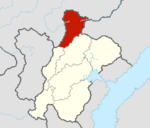
|
| Paranani Province | Ghobari | Ekaraj Verma | Bichitra Chalise | 13 | X | 3,199,272 | X | 0.519 | 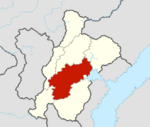
|
| Nyandak Province | Lhakpa | Wangyal Dramuktsang | Chodak Gonpo | 10 | X | 1,570,418 | X | 0.469 | 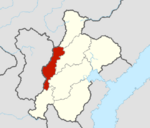
|
| Bhetwal Province | Godapyuri | Ganga Prasad Yadav | Nepuchi Bhatta | 9 | X | 2,552,517 | X | 0.478 | 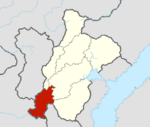
|
| Mahana | Jutpandi | President Bina Sharma |
Prime Minister Ranju Bastola |
74 | X | 29,686,017 | X | 0.581 | 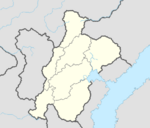
|
Territorial Disputes
Mahana shares disputes over borders with neighbouring Namdatka over the Thubten Province which is claimed by Namdatka for it's large population of ethnic Namdatkans. Mahana do not formally recognise the claim[11] over the region despite persistent claims from Namdatka. The region was formerly a part of Namdatka before the war between Mahana and Namdatka[12] in 1813, where the land was taken from Namdatka and given to Mahana as part of the peace treaty. As of Mahana's most recent census, the Thubten Province is made up of roughly 63% directly Namdatkan peoples as well as 78.3% broad Careleon ethnic groups, such as the Koshi people who share a lot of their ethnic background and culture with the Namdatkan people.
Military and Intelligence
The military in Mahana is handled by the Mahanan Ministry of Defence. The military expenditure for 2017 was 431 million, around 1.5% of the countries GDP. An almost exclusively ground force of soldiers, the Mahanan Army numbers at less than one hundred and fifty thousand. The military own few aircraft, mainly helicopters used in search and rescue, usually in the Samripes. The military is lead by the Head of Defence, currently Kusum Paudel. The Directorate of Military Intelligence is under the army in Mahana; the National Intelligence Agency acts seperately, however. The military in Mahana is primarly used for search and rescue, anti-poaching in national parks and counterinsurgency. There are no discriminatory policies in joining the army, and haven't been since 2006 when women were allowed to enlist, however in order to join one must complete the harsh Pugati Test.
However, some of the most iconic and feared soldiers in the world, the Durkhas, are Mahana's most proud soldiers. Originally formed in the mid-1700s, the Durkhan soldiers are highly regarded as some of the most skilled and fearless soldiers in the world. The Durkhas are recruited for the Mahanan Army, the Mekabiri Army and notably the Delamarian Army.
Refugees and Immigrants
Mahana has a long and rich history of accepting refugees. In modern times Zekistani and Namdatkan refugees make up a majority of the refugees in Mahana. Namdatkan refugees began to come into Mahana in 1960, with many entering the country each year. Zekistani refugees came to Mahana in 2006, upon the outbreak of the War of Khudyana, and numbered at over 120,000 as Mahana opened it's border to fleeing refugees.
Foreign Relations
Mahana heavily depends on diplomacy for national defence due to a weak and poorly governed military. It maintains a general neutral foreign policy toward conflicts involving it's neighbours as well as having amicable relations with other countries in the Orient. As of 2022, Mahana is a full-time member of the Entente of Oriental States for purely defencive purposes. The reasoning for their joining of the pact was due to the unreliability of the government in neighbouring Zekistan. They are also a member of the AN and OARC among others. It maintains bilateral relations with 108 AN member states as well as TRIDENT and the Aurelian League. Mahana has embassies in 48 countries, including Ahrana and Tagmatium, and 50 countries have embassies in Mahana, located entirely within the city of Jutpandi. Mahana has been a huge contributor to AN foreign peacekeeping missions, having contributed 50,000 personnel to over 40 missions since 1958. Mahanan diaspora in other parts of the wurld have earned a reputation for being honest, brave, hard-working and loyal which has lead to many serving as great Durkha warriors in many foreign armies over the last 200 years. Durkha have served in the First Argic War and the Second Argic War, the Bashan War and the civil war in Zekistan. Although Mahana was not directly involved in any of these conflicts, Mahanans have been awarded great accolades such as the Geroge Cross.
Mahana pursues a policy of "balanced relations" with it's two warring neighbours, Kotowari and Zekistan. Despite this, the 1970 Friendship Treaty with Kotowari results in much closer relations with them than with Zekistan however Mahana notably introduces and takes in refugees and asylum seekers from Zekistan in high numbers. Kotowari and Mahana share an open border with free movement of people.
Economy
Mahana's GDP (Gross Domestic Product) for 2021 was $36.084 billion with an annual growth rate calculated at 4.9% in 2021, which is expected to rise to 6.5% by 2025. Mahana could be considered to be one of the fastest growing economies in Europa, however with one of the lowest GDP nominal per capita.
The 17.9-million-worker Mahanan Worker Force is one of the largest on Eurth. Primary work sectors make up to 34.2% of GDP, the secondary 14.3% and the tertiary 51.5%. Major agricultural products include tobacco, potato, oilseed, jute, cereal (barley, maize, millet, paddy and wheat) and milk. Major industries include tourism, cigarettes, textiles, cementing, rice, sugar and bricks. Mahana's international trade expanded greatly in the 1990s as a complete democratic system was restored. Mahana's economy was ruined in the 1990s following the Mahanan Civil War. Major exports of Mahana include leather, carpet, medicinal herbs and paper product. Major imports of Mahana include machinery, raw materials, plastic, tea, electrical and electronic devices, gold and semi-finished goods.
In recent years Mahana has made great progress in poverty reduction as well as reducing the gap in development. In 2010 Mahana was below the International Poverty Line (AIA$1.90 per person per day) from 17.3% to just 9.9% in 2019, however vulnerability still remains high as almost 34% of the population living on between $1.90 and $3.45 per day. However, Mahana has made great improvements to sectors such as infant mortality, nutrition, electricity and access to internet. On the current trajectory, Mahana is set to eliminate poverty within the next 35 years. Mahana's agricultural sector comes under great risk as during the months June-September the Narope Rains cause floods in the lowland regions, which Mahana relies on for a lot of the farming. As of 2014, Agriculture employs 76% of the workforce, services 18%, and manufacturing and craft-based industry 6%.
Besides being almost landlocked, rugged and harsh geography, poor infrastructure, ethnic tension and lack of natural resources as well as long lasting civil war tensions, the post-1990 government has done a good job stabilising the country.
Tourism
Tourism is the largest and fastest-growing industry in Mahana, employing more than 1.5 million people. The industry also contributes to around 9.7% of Mahana's GDP. The number of international visitors to Mahana surpassed 1 million for the first time in 2012, with that number increasing each year (statistic not including those who travel on the road from neighbouring countries). Premier destinations in Mahana include the Sheshtri National Park (Home to Mount Monjara), the seaside city of Daruwa, the cultural city of Jutpandi, the Pashni Ski Resort and the Ghobari Valley.
Foreign Employment
Today Mahana remains a poor country, with most working in farming. However, Mahana is seen to have great tourist potential with 26 million visitors in 2020. They are exporters of materials such as plastics and soft metals as well as tea and other goods.
Infrastructure
Energy
A majority of Mahana's energy source comes from biomass (around 75%) and foreign imported fossil fuels (17%). A majority of the final energy goes into the residential sector (84%) followed closely by transport (7%) and industry (6%). The transport and industry energy usage has been rising rapidly since 2019. Except for some lignite deposits, Mahana has no known oil, gas or coal deposits. The diverse and perennial nature of Mahanan rivers along with the steep gradient of the country's topography makes for near ideal conditions for the development of hydroelectric projects. All of Mahana's commercial fossil fuels are imported from abroad, notably from Zekistan and Kotowari. Estimates put Mahana's economically feasible hydro-power potential at around 50,000 MW, one of the highest on Eurth. So far of this 50,000 Mahana has been able to exploit around 3,300 MW, mostly generated from ROR plants.
Transportation
Mahana is located away from most of Europa's major land, air and sea transport routes however the state of aviation in Mahana is still thriving. Mahana has 49 airports, 1 international airport and 17 airports with paved runways, including the notable Simikot Airport which has "the most dangerous runway in the wurld". Flights are frequent and help to support the congested traffic along the poor road system. The hilly and mountainous terrain of the country makes it difficult for transport to thrive on land, with Mahanan highways being congested. This leads to many taking off-road paths which may be potentially dangerous. In 2022 Mahanan Prime-Minister Ranju Bastola announced his plan for road and highway improvement for 2023. [13] Most of the rural roadworks are not open during rain seasons, due to poor condition.
Media
As of April 2019 the state owns three TV stations and four radio shows. There are over 129 private TV channels, most popular being Ghobara TV. There is over 760 liscenced FM radio stations, with over 220 of them being local community radio stations. In accordance with the 2012 national census around 78.4% of all households had access to radio, 46.5% had access to TV and computer access was around 12.2%. According to the Press Council Mahana classification, as of 2017 of the 867 publications producing original content, ten national dailies and weeklies are rated A+ class.
Urbanisation
Largest cities or towns in Mahana
National Census 2020 | |||||||||
|---|---|---|---|---|---|---|---|---|---|
| Rank | Regions | Pop. | Rank | Regions | Pop. | ||||
 Jutpandi Daruwa |
1 | Jutpandi | Nuragara Province | 1,674,394 | 11 | Manwuri | Banurati Province | 59,333 |  Ghobari  Veydu |
| 2 | Daruwa | Banurati Province | 874,395 | 12 | Dipsar | Paranani Province | 33,693 | ||
| 3 | Ghobari | Paranani Province | 623,442 | 13 | Manasha | Banurati Province | 23,495 | ||
| 4 | Veydu | Sadheshi Province | 340,493 | 14 | Katsang | Banurati Province | 19,384 | ||
| 5 | Battagara | Nuragara Province | 301,990 | 15 | Baruni | Paranani Province | 17,495 | ||
| 6 | Potaro | Banurati Province | 244,394 | 16 | Jangadi | Banurati Province | 14,895 | ||
| 7 | Bhuram | Sadheshi Province | 198,000 | 17 | Lhakpa | Nyandak Province | 11,503 | ||
| 8 | Lumbini | Nuragara Province | 143,599 | 18 | Godapyuri | Bhetwal Province | 8,586 | ||
| 9 | Pokura | Nuragara Province | 111,293 | 19 | Birendranagar | Nuragara Province | 4,394 | ||
| 10 | Durkhi | Banurati Province | 78,000 | 20 | Nilkantha | Sadheshi Province | 4,129 | ||
Culture
Ethnic Groups
Mahana is one of Eurth's most ethnically diverse nations, with tens of different ethnic groups of notable size making up the modern day nation. The reason for this is the historic separation and isolationism meant that different peoples grew slightly different from each other, forming the modern ethnic makeup of Mahana. A huge majority of the people living in Mahana are native groups, an estimated 98.7% of their population in 2021.
The largest ethnic group in Mahana is the Sheshtri peoples, part of the Mardri ethnic family, alongside the Jamuni, Butwali, Pashimari, Mai and Shivalaya, as well as other smaller groups. These groups are most often found in the Outer Careleon Plateau as well as the lowlands Ripal region. These people are closer to the regular Oriental ethnic groups, as they have had more interaction with the outer world than the Patuan family of ethnic groups. The Patuan Ethnic Family originates in the Patu region of Mahana, specifically the Inner Careleon Plateau, however some members of the family can be found as far east as the Samripes. Some members of the Patuan Family include the Gaimreti,Koshi, Tamang, Jhimpe and Kiralimbu. The main difference between the Patuan and Mardri families, besides general appearance, is the language. The Mardri peoples speak Mahanan and the Patuans frequently speak the Carelitan language, however Mahanan has become the primary language with almost all citizens speaking the language.
Society
Religion
Mahana is a land of incredible religious importance for three religions; Gaism, Buddhism and Hinduism. Mahana is religiously diverse, with the three main religions being Gaism, Buddhism and Hinduism.
Mahana is the motherland of the Gaism religion, with it being founded in the Ghobari Valley. The earliest evidence of the religion was dated to around 4,000 years ago. The leader of the religion, the Gai, can be found within the capital city of Jutpandi. A huge amount of pilgrims visit Mahana each year, specifically following the Nurumi Religious Pilgrimage Route.
Mahana is also of great importance to Buddhists, as it is believed the religion originated in Mahana, although some argue the validity of this claim. It is believed that Vuatma Buddha was born in Mahana, who went on to found the Buddhism religion. The city of Lumbini receives around 400,000 Buddhist pilgrim visitors a year.
Despite historically having a much larger presence in Mahana, Hinduism still makes up around 9.0% of the total population as of 2021. The Hindu populations decline began during the 'Religious Insurance' period of the mid-to-late 1700s, and has continued a steady decline since with the majority of the Hindu population around Menelassar being in Kotowari to the north.
Cuisine
Mahanan cuisine consists of a wide variety of regional and traditional cuisines. Rice (red rice), buckwheat, and increasingly maize, are the staples of Mahanan cuisine. Given the range of diversity in soil type, climate, culture, ethnic groups, and occupations, these cuisines vary substantially from each other, using locally available spices, herbs, vegetables, and fruit. Cereals also make up a part of Mahanan cuisine, their types, choices and regions of planting correspond strongly with the Narope Rains as well as the variations of altitudes. Mahanan cuisine also includes a variation of spices as well as potato, the tomato, maize, peanuts, cashew nuts, pineapples, guavas, and most notably, chilli peppers which initially were introduced into Mahana through the Pearl Road network and have become a large part of the traditional Mahanan cuisine. Rice and wheat are mostly cultivated in the Mahanan Lowlands and well-irrigated valleys such as the northern Ghobari Valley, and maize, millet, barley and buckwheat in the lesser fertile and drier hills as well as the Patuan regions.
A notable feature of Mahanan food is the existence of a number of distinctive vegetarian cuisines, each a feature of the geographical and cultural histories of its adherents. This origiantes through early Gai teachings which prohibits the harm of life, similar to much of Oriental Europa. These teachings also apply to other Mahanan religions such as Buddhism and Jainism. Though meat consumption per capita is low, it is not as low as in neighbouring Kotowari due to the Gai practise of Chaktism, which animal sacrifice plays a large role.
The most famous dessert eaten in Mahana, and part of their national dish, is Koppai, a sweet frozen dairy dessert.
Mahanan cuisines, with generally tomato-based, leaner curries, are lighter than their cream-based Kotowaran counterparts, and Mahanan momo dumplings are heavily spiced compared to their southern Mekabirian counterparts. Jamuni cuisine, one of the richest and most influential in Mahana, is more elaborate and diverse than most, as Jamuni culture developed in the highly fertile and prosperous Ghobari Valley. A typical Jamuni cuisine can comprise more than a dozen dishes of cereals, meat, vegetable curries, chutneys and pickles.
Arts and Architecture
The earliest examples of architecture are the stupas built by the early Ghobari Valley Civilisation, most notably the stupa in Sanchi. The characteristic architecture associated exclusively with Mahana was developed and refined by the architects of during the Jhuapi Punha Dynasty and the Suwa artisans of the period. An Orinese travel book based off of records from around 400AD describes contemporary Mahanan architecture, predominantly built with wood, as rich in artistry, as well as wood and metal sculpture. It describes a magnificent seven-storied pagoda in the middle of a palace, with copper-tiled roofs, its balustrade, grills, columns and beams set about with fine and precious stones, and four golden sculptures of Nakaras in the four corners of the base spouting water from their mouths like a fountain, supplied by copper pipes connected to the runnels at the top of the tower. The roofs usually tiled with clay, and sometimes gold plated, diminish in proportion successively until the topmost roof is reached which is itself ensigned by a golden finial, known as pagodas. The base is usually composed of rectangular terraces of finely carved stone; the entrance is usually guarded by stone sculptures of conventional figures. Bronze and copper craftsmanship is common in Mahanan architecture due to the abundance of the materials in the region. These are also avaliable in the sculptures of deities and beasts. The Marangu and Kyatapola temples are the finest examples of Mahanan woodsmanship. The "ankhijhyal" window, that allow a one-way view of the outside world, is an example of unique Mahanan woodcraft, found in building structures, domestic and public alike, ancient and modern.
The most well-developed of Mahanan painting traditions is the thanka or paubha painting tradition of Namdatkan Buddhism, practised in Mahana by the Buddhist monks and Jawuri artisans.
Symbols

The notable symbol Mahana uses which features in the flag, emblem and various national symbols is the Khurandan Wheel, the holy symbol of Gaism which has a heavy presence in the region. The symbol of the wheel has been seen in Mahanan culture as early as the 3rd century and has been prevelent in the area since, featuring on the national flag for the first time in 1601 and until it was changed to the symbol of the monarchy in 1804. It wasn't until 1993 when it was re-introduced to the flag in the post-war redesign.
Mahana's national anthem is "Rastiyah Ghaan" and has been since the establishment of the Federal Democratic Republic in 1993. It was composed and written by Safusa Purewal and accepted by the government in 1993 officially. The song traditionally features instruments from Mahana, however is often played without in international showings. Such instruments include the Madal, the national instrument.
Mahana's national animal is the cow, being the sacred animal of Gaism it holds great importance to the people. In 2014, the government banned the slaughter of cows within the nation and all beef-related product is imported from foreign countries to respect the religion and it's holy lands. This does not mean it is illegal to eat beef, however.
The flag of Mahana, created following the civil war in 1993.
- Coat of arms of Mahana.png
The Mahanan Coat of Arms, made official in 2005.
A Rhododendron, the national flower of Mahana.
A Mahanan Juniper, the national tree of Mahana.
A Sanga cattle, one of the national animals of Mahana.
A depiction of the Samripen cock-of-the-rock [14], one of the national animals of Mahana
Sports and recreation
The Mahanans play many sports at national as well as at international level. The most common sport played in Mahana is football, followed by cricket. Other sports played in the country include swimming, volleyball, tennis, martial arts, boxing, wrestling, running, weightlifting, basketball, shooting, archery, badminton and golf.
At the Olympic Games Mahana has won a total of 14 gold medals in the nations history, with boxer Max Nastra winning 6 of the gold medals in the games.
The most popular sport in the country, football, is enjoyed internationally with the Mahanan Blue Coats National Football Team, and nationally with the Mahanan Primiyara Liga. Mahana's best known football player is Raju Wise who is the all-time top scorer for Mahana. Mahana is a member of UENA and belongs to the ECFA.
References
- ↑ These groups are often classed altogether as Mahanan
- ↑ "An Analysis of Mahana's Ethnic Makeup" (PDF) J.L. Allcott Retrieved 3rd June 2022.
- ↑ "The Kingdom of Mahana preceeded the current state, being the sovereign state previous to the Civil War of the early 1990s" - University of KWC (PDF) Retrieved October 3rd 2022
- ↑ "Mahana on Europans" (PDF) Retrieved 3rd June 2022
- ↑ Iqu, Rajuun, A. (2003). The National Encyclopedia of Mahanan History and Culture (2nd ed.). O'Polis: University of O'Polis Press. pp. 99-102. ISBN 918-0-28319-399-2.
- ↑ "The History of the Aaya" (PDF) - AA Singh, Kotowari City College retrieved 3rd June 2022
- ↑ "The Mahanan Caste System (PDF) Retrieved 3rd June 2022
- ↑ Mahana-EOS Relations, retrieved 3rd June 2022.
- ↑ "For more on the history of the region -> History of Central Orient" (PDF). Retrieved 21 June 2022
- ↑ "The number may only be estimated as it was not properly recorded at the beginning of the pandemic, figures range from 150-450 thousand people." - Dr. Kuldeep Ranjit of the University of Veydu. Retrieved 5th June 2022
- ↑ "The Thubten Issues" (PDF) - Jalton D. Singh. Retrieved 10th June 2022.
- ↑ "Conflict of Vivāda (1812-1813)" (PDF). Retrieved 10th June 2022
- ↑ Mahanan Government Announce 2023 Target. via Europans, (JPG) Retrieved 1st December 2022.
- ↑ "Cock-of-the-rock made national bird of Mahana." - World Times (PDF). Retrieve 12th June 2022
External Links
Europans

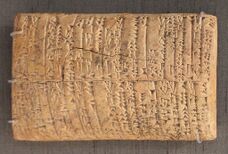


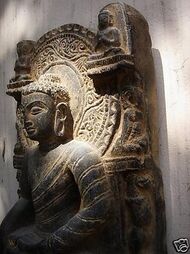






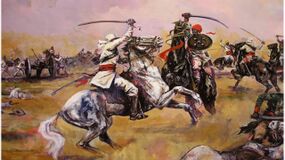
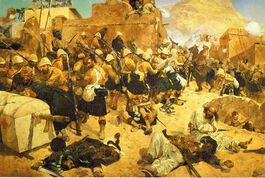


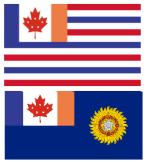
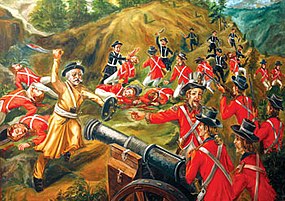
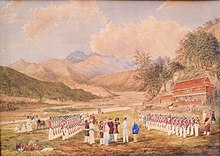




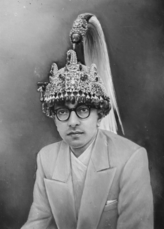
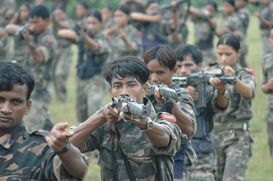
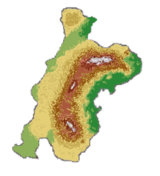

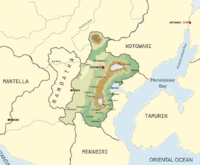
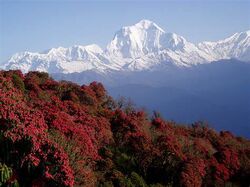
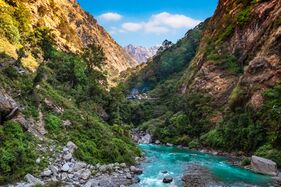
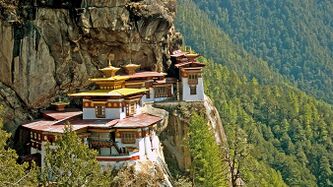













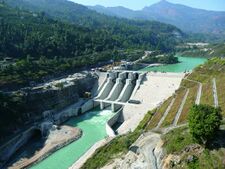
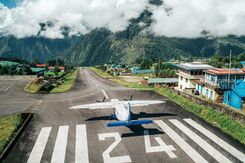
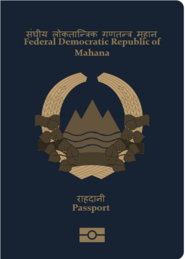
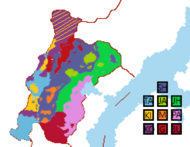

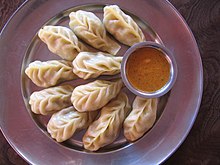

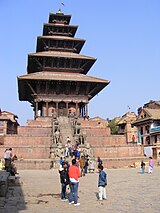




![A depiction of the Samripen cock-of-the-rock [14], one of the national animals of Mahana](https://upload.wikimedia.org/wikipedia/commons/thumb/3/3d/Rupicola_peruviana_%28male%29_-San_Diego_Zoo-8a.jpg/150px-Rupicola_peruviana_%28male%29_-San_Diego_Zoo-8a.jpg)
